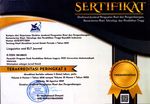STUDENTS' ENGAGEMENT IN ONLINE LEARNING USING WHATSAPP GROUP DURING COVID-19 PANDEMIC
Abstract
Keywords
Full Text:
PDFReferences
APJII. (2020). Buletin APJII. Asosiasi Penyelenggara Jasa Internet Indonesia, p. 1. Retrieved from https://apjii.or.id/content/read/104/503/BULETIN-APJII-EDISI-74---November-2020
Appleton, J. J., Christenson, S. L., & Furlong, M. J. (2008). Student engagement with school: Critical conceptual and methodological issues of the construct. Psychology in the Schools, 45(5), 369–386. https://doi.org/10.1002/pits.20303
Arikunto, S. (2011). Prosedur Penelitian: Suatu Pendekatan Praktik. Jakarta: Rineka Cipta.
Belawati, T. (2019). Pembelajaran Online. Jakarta: Universitas Terbuka.
Fredricks, J. A., Blumenfeld, P. C., & Paris, A. H. (2004). School engagement: Potential of the concept, state of the evidence. Review of Educational Research, 74(1), 59–109. https://doi.org/10.3102/00346543074001059
Fredricks, J. A., Filsecker, M., & Lawson, M. A. (2016). Student engagement, Context, And adjustment: Addressing definitional, Measurement, And methodological issues. Learning and Instruction, Vol. 43, pp. 1–4. https://doi.org/10.1016/j.learninstruc.2016.02.002
Hwang, G.-J., Lai, C.-L., & Wang, S.-Y. (2015). Seamless flipped learning: a mobile technology-enhanced flipped classroom with effective learning strategies. Journal of Computers in Education, Vol. 2, pp. 449–473. https://doi.org/10.1007/s40692-015-0043-0
Jimerson, S. R. (2003). Toward an Understanding of Definitions and Measures of School Engagement and Related Terms. (January). https://doi.org/10.1007/BF03340893
Kahu, E. R., & Nelson, K. (2018). Student engagement in the educational interface: understanding the mechanisms of student success. Higher Education Research and Development, 37(1), 58–71. https://doi.org/10.1080/07294360.2017.1344197
McConnell, D. (2017). E-learning in Chinese higher education: the view from inside. Higher Education, 75(6), 1031–1045. https://doi.org/10.1007/s10734-017-0183-4
Perveen, A. (2016). Synchronous and Asynchronous E-Language Learning: A Case Study of Virtual University of Pakistan. Open Praxis, 21-39.
Peterson, C. (2006). A Primer in Positive Psychology. New York: Oxford University Press.
Premlatha, K. R., & Geetha, T. V. (2015). Learning content design and learner adaptation for adaptive e-learning environment: a survey. Artificial Intelligence Review, 44(4), 443–465. https://doi.org/10.1007/s10462-015-9432-z
Reeve, J. (2012). Handbook of Research on Student Engagement. In S. L. Christenson, A. L. Reschly, & C. Wylie (Eds.), Handbook of Research on Student Engagement (pp. 149–172). https://doi.org/10.1007/978-1-4614-2018-7
Subramainan, L., & Mahmoud, M. A. (2020). A systematic review on students' engagement in classroom: Indicators, challenges, and computational techniques. International Journal of Advanced Computer Science and Applications, 11(1), 105–115. https://doi.org/10.14569/ijacsa.2020.0110113
Sugiyono. (2019). METODE PENELITIAN KUANTITATIF, KUALITATIF dan R&D (2nd ed.). Bandung: Alfabeta.
Taylor, J. (2001). Fifth generation distance education. Higher Education Division, 40(40), 1–8. Retrieved from http://ascilite.org.au/ajet/e-jist/docs/vol4no1/contents.htm
Zuriah, N. (2009). Metodologi Penelitian Sosial dan Pendidikan Teori Aplikasi (Vol. 3). Jakarta: Bumi Aksara.
DOI: https://doi.org/10.31764/leltj.v10i1.8387
Refbacks
- There are currently no refbacks.
Copyright (c) 2022 Linguistics and English Language Teaching Journal

This work is licensed under a Creative Commons Attribution-ShareAlike 4.0 International License.
_____________________________________________________
Linguistics and ELT Journal
p-ISSN 2339-2940 | e-ISSN 2614-8633

LELTJ is licensed under a Creative Commons Attribution-ShareAlike 4.0 International License.
_____________________________________________________
LELTJ is abstracting & indexing in the following databases:
_____________________________________________________
LELTJ Editorial Office:













